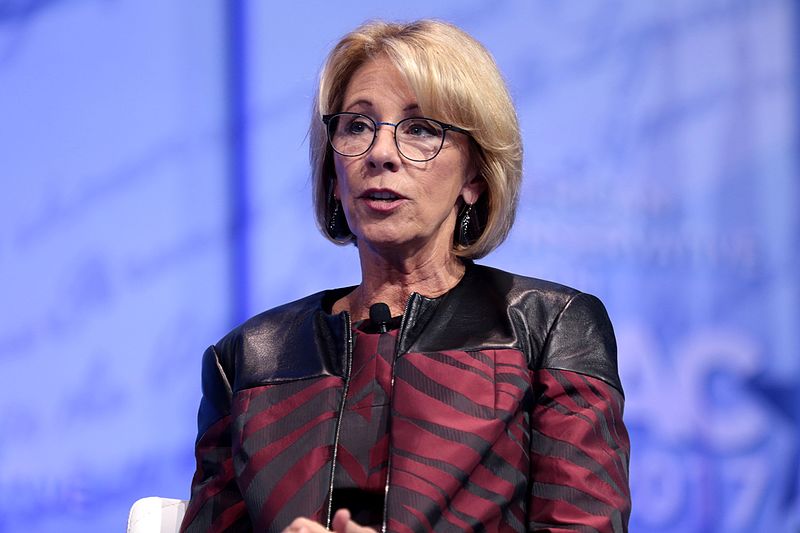On Nov. 16, Education Secretary Betsy DeVos announced the release of a campus sexual assault policy proposal that, if enacted, would reduce liability for universities and narrow the definition of sexual harassment. It would also allow cross-examination between the accused and accusing parties, although not between the accused and accuser themselves.
The new policy would overhaul Title IX regulations created under President Barack Obama. Stanford, however, maintains that it would not influence the University’s current sexual assault procedures.
“Nothing changes today in our campus Title IX procedures as a result of this development,” Provost Persis Drell wrote in a “Notes from the Quad” post. “We fully intend to continue our efforts to reject sexual violence in our community, to support survivors, to hold perpetrators accountable and to have fair adjudication processes.”
Once DeVos’ policies are published in the Federal Register — a journal of the U.S. government that publishes all proposed government regulations — the rule will be open for public comment for 60 days, during which time individuals and institutions can provide feedback. Following the public comment period, the policy will have the force of law, unlike current Obama-era guidelines.
The Stanford administration intends to participate in the public comment period, according to Drell’s post. The Associated Students of Stanford University (ASSU) also plans on participating in the comment period, serving as a resource for students who want to give their own feedback.
“ASSU will be participating in the notice and comment process, as well as providing tools and resources for students who wish to participate in the notice and comment process as well,” said ASSU Executive President Shanta Katipamula ’19.
A petition to request that the Department of Education extend the comment period for the regulations to allow for further student input has also begun circulating among students across the country.
The proposed changes
The proposed policy narrows the definition of sexual harassment, defining it as unwelcome conduct so “severe, pervasive and objectively offensive” that it denies a person equal access to education. In contrast, Obama-era rules define sexual harassment more generally as any “unwelcome conduct of a sexual nature.”
DeVos’ guidelines would also make it more difficult to hold schools liable for an assault. Under Obama-era rules, a school is deemed liable if it “reasonably should [have]” known about an assault. Under DeVos’ proposed changes, the school would only be held responsible if it had “actual knowledge” of the harassment that occurred. Additionally, the accuser would have to report their accusation through official channels; telling someone like a resident adviser or a peer health educator would not be sufficient for the university to be liable. If the assault occurred off campus — like in an off-campus residence — the university would also not be held liable.
The policy would also allow schools to choose to use a higher burden of proof when conducting investigations — a “clear and convincing” standard — that calls for more evidence to find the accused party responsible for misconduct. As of now, Obama-era regulations mandate a “preponderance of evidence” standard, the lower of the two standards.
Under the new regulations, universities would be required to hold a live hearing where both parties’ advisors could cross-examine the other party. Cross-examination between the accuser and the accused would not be allowed.
Stanford community responds
DeVos said in a statement that the new rules are intended to make the Title IX proceedings “more transparent, consistent and reliable in their processes and outcomes.“ However, some Stanford students and faculty disagree.
“[DeVos’ regulations] will not increase fairness to students accused of sexual misconduct but will absolve schools of responsibility for harmful behavior perpetrated under their watch,” said ASSU co-director of sexual violence prevention Emma Tsurkov J.S.M ’15. “The proposed new regulations benefit institutions at the expense of harming individuals already harmed by sexual violence, creating secondary victimization and a betrayal of trust.”
Stanford Law School professor Michele Dauber, who led the successful movement to recall former California Judge Aaron Persky, said she is particularly concerned with the cross-examination provision.
“[The provision] is a chilling proposal that will drop campus sexual assault reporting to rock bottom,” Dauber said.
For now, Stanford will continue following Obama-era regulations and adhering to California law, “which in many respects goes beyond the federal guidance we had been operating under since 2011,” Drell wrote in her blog post.
Tsurkov said she hopes the University will remain committed to Obama’s regulations.
“We call on the University to use this moment of unfortunate betrayal of victims of gender-based violence by the federal government, to strengthen its commitment to making Stanford a safe campus by publicly vowing to retain, to the extent possible, all the protections to victims guaranteed by the Obama administration,” she said.
Drell indicated that this will remain the case.
“We’ve made continuous efforts at Stanford over the last many years to strengthen our programs and processes to prevent and respond effectively to sexual violence,” she wrote. “Creating a healthier community with healthier relationships continues to be a major priority for us. We’ll contribute thoughtfully to the discussion of the proposed new rules with that priority firmly in mind.”
Students wishing to provide input on Stanford’s comment can email either Drell or ASSU executive leadership. In addition, ASSU will be offering comment workshops for students.
Contact Adesuwa Agbonile at adesuwaa ‘at’ stanford.edu.
